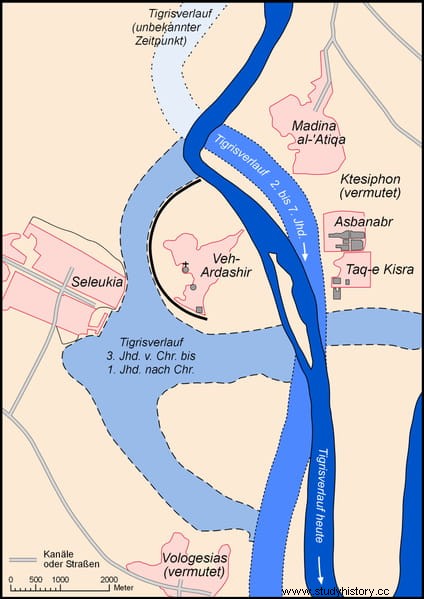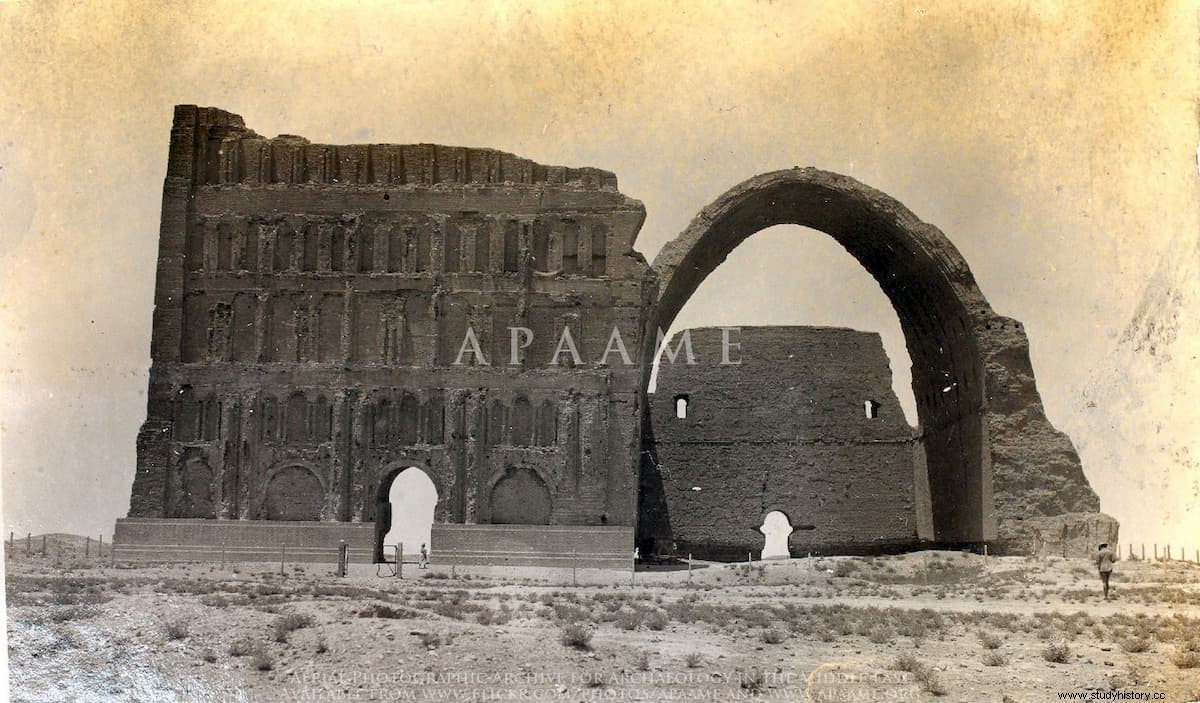The Sassanid dynasty was founded by Ardacher I in AD 226, ruling Persia from the city of Ctesiphon, the capital of the Parthian Empire which he had defeated.
Actually Ctesiphon began as a neighborhood of ancient Seleucia, the city founded by Seleucus I Nicator (one of Alexander the Great's diadochi) in 312 BC. on the western bank of the Tigris, right in the center of present-day Iraq. The city grew so much that by 221 B.C. it had already crossed the river, and on the eastern bank a new neighborhood was born. When the Parthians conquered it in 141 B.C. They decided that this neighborhood on the eastern shore, already called Ctesiphon, was going to be their new capital.

Seleucia-Ctesiphon thus became a cosmopolitan cultural hodgepodge where Parthians, Persians, Babylonians, Greeks, Jews, Assyrians and Arabs lived together. And in one of the largest cities in the world during the Hellenistic and Roman periods.
Ctesiphon changed hands between the Parthians and the Romans several times. When the Sassanian Persians put an end to the Parthian empire in 226 AD, they established their capital there, which was also the subject of continuous battles, sieges and conquests between the Sassanids and the Romans, and later the Byzantines. Emperor Julian himself died in front of its walls in the siege of the year 363 AD

The most famous of all the Sassanian kings (whose empire extended until 651 AD, thus encompassing the entire final stage of Antiquity and the first centuries of the Middle Ages) was Khosroes I. It was he who promoted the construction of new and imposing buildings in the capital, beautifying it like no other king had done before. Under his reign, between 531 and 579 AD, Ctesiphon reached its greatest splendor.
In 637 AD the Muslims conquered Ctesiphon (which they called Al-Mada'in) which, after the founding of nearby Baghdad in 761 just 24 kilometers to the northwest, would gradually lose population until it was completely abandoned. So much so that today only a visible surface remains of it, the Taq Kasra o Great Arch of Ctesiphon (also called Taq-i Kisra ).

The ruins are next to modern Iraqi Salman Pak. They consist of the remains of the old imperial palace whose construction began in 540 AD, although there are historians who place the beginning of the works in the 3rd century, in the time of Sapur I, who was the second Sassanian king.
The impressive parabolic arch that covers the central chamber was built without falsework, and is considered to be the largest unreinforced brick vault in the world. It reaches 37 meters in height on what could have been the Sassanian throne room, 26 meters wide and 50 meters long. The upper part of the arch is 1 meter thick, while the base walls reach 7 meters.
The part open to the outside under the arch was probably the audience hall, where the Sassanid king received envoys from other kingdoms. The Arabs, however, used it as a mosque, until during the 10th century its bricks began to be used for the construction of the Taj Palace in Baghdad.

It appears that the interior of the room was decorated with mosaics, fragments of which have been found nearby. The Arab historian Qazwini states that the wall of the throne room was decorated with an image of Khusrow riding a yellow horse.
The Byzantine historian Theophylact Simocates, writing in the first half of the 7th century AD. and is one of the main sources for the history of Persia, says that

Unfortunately, much of the building was demolished in 1888 as a result of a serious flood. It began to be rebuilt by the Iraqi government in the 1980s, rebuilding the collapsed north wing and completing the work in 2017. However, it suffered a partial collapse again on March 7, 2019.
Curiously enough, in 1940 the writer Roald Dahl, then undergoing RAF pilot training near Baghdad, flew over the area and took a photograph of the Arch of Ctesiphon, which won an award.

The Great Arch of Ctesiphon would be the inspiration for many other later buildings. In fact, the modern inverted catenary arch bears the name of ctesiphon arch thus. The uniqueness of this arch is that it supports itself:the tension that occurs at each point of the arch is distributed between a vertical component and a pressure component that is transmitted from the arch to the foundations without the need for vertical efforts , except in the lower part, reaching the foundations, so it does not need the addition of lateral supports.
